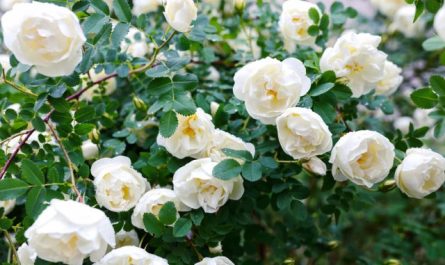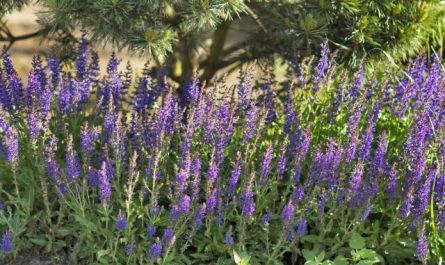Most people have heard of English roses. This is the name given to the delightful flowers created by David Austin, also known as Austin roses. These plants are hybrids, bred using old garden roses and modern shrubs to combine the best characteristics of both. Today, these roses can be seen everywhere: from designer gardens to your neighbor’s cottage. Let’s talk about them in more detail.

History of English Roses
English roses were developed by British rose breeder David Austin and rose to prominence in the 1970s. To create his signature varieties, he crossed old garden roses (usually Gallicas) with modern varieties such as hybrid teas and floribundas. Over the years, Austin added Bourbon, Portland, Alba, Wichurana and descendants of the Rugosa rose to his hybrid lines.
He attempted to create what he called “new old roses” by taking the elegance, fragrance, and beauty of Old World plants and combining them with the color, disease resistance, and repeat flowering of modern varieties. Austin drew inspiration for the names of his creations from literature, music, and places he found particularly beautiful. Many varieties are also named after people close to him.
Given their incredible popularity today, it’s hard to believe that at first no one wanted to buy Austin hybrids because they looked “old fashioned.”
Eventually, flower growers were able to appreciate such new products. One of Austin’s first successes was the ‘Constance Spry’ variety, which was the result of crossing the floribunda ‘Dainty Maid’ and the Gallic rose ‘Belle Isis’.

The main advantages of the new variety are said to be its fragrance with a distinct sweet aroma of myrrh (extremely rare in roses before Austin’s efforts), and large, deeply cupped, double flowers of pink color.
He then tried to combine the deep crimson colour found only in modern hybrids with the shape and scent of old roses. The result was the Chianti variety, which has since become the basis for many dark red varieties.
David Austin continued his work on English roses until his death in 2018.
Types of English Roses
Austin’s roses are classified by the American Rose Society (ARS), the organization responsible for registering new plants. When Austin registered his plants with the ARS, he categorized them as shrubs. However, he liked to group his creations into their own subcategories. Although they are not officially recognized by the ARS, they still give us some idea of how to understand the different types he created.
Old Rose Hybrids
This category includes Austin’s first attempts at creating “new old roses.” They tend to have smaller flowers and a smaller range of colors than his other plants. In this group, you’ll see pinks, crimsons, and purples. They’re all fragrant and bloom repeatedly throughout the season.

Leanders
This group is based on old hybrid roses, including the rose Wichurana. They usually have large flowers in a wide range of colours, including yellow, apricot and fiery red. The roses are very fragrant, with a rare original scent (raspberry, lemon and apple).

English Musk
English musk roses were developed by crossing old Austin varieties with Noisettes, hybrids that originated in the United States in the early 1800s. Noisettes are known for their bushy growth habit and large, medium-sized blooms.

Due to their genealogy, this group has more delicate flowers and a shorter stature than the previous two classes. They typically have clusters of pastel flowers in pink, yellow, apricot and peach. What they lack is scent, but they do bloom repeatedly.
Hybrids of English roses Alba
This is the newest group. According to Austin, they have a more “wild” growth habit, meaning they are less compact and upright. Most of them are the result of crossing the Alba rose with its English types. Almost all are pink. Although their flowers are small, they are very beautiful with many petals.

Some other English roses
This is what Austin called all the other English roses he bred that didn’t fit into any of the above categories. As you might expect, this is a diverse and difficult to define group. You’ll find most of the climbers and groundcovers here.
Austin Rose Care and Growing Tips
If we could ask Austin himself, he would say that all his roses need is a little compost when planting and regular pruning by 1/3 and that’s it. But with more effort, the plants will produce larger flowers and more abundant blooms. If you want to get the most out of your flowers, consider the following tips.
to the coverage requirements
Austin roses were bred in England, where the sun is not as intense and there is considerable cloud cover. This should be kept in mind when choosing a site. Although they, like all roses, require a fair amount of direct sun daily, protection from our intense midday sun is preferable. Locations on the east and west sides of the plot are excellent for planting. David Austin claimed that northern areas are also suitable, but in such places there is no additional shade from trees or buildings. If roses do not receive at least five hours of sun per day, the number of flowers is significantly reduced and the risk of disease increases.

Plant the bushes away from trees, as roses do not like to compete with other plants at the root level.
Since all of these plants are grafted, be sure to place the grafting point about 5 cm below the soil.
Austin believed that English roses should be grown in groups. Two or three specimens planted together make a greater impression than a single bush.
Pruning rules
David Austin varieties are repeat bloomers, so after a full bloom in early summer, they will continue to produce flowers sporadically for the rest of the season. During the growing season, deadhead spent flowers and remove any dead or diseased growth you see.
While some recommend pruning roses at an angle or near a leaf bud, Austin says it doesn’t matter for his roses. As for the pruning process, it varies slightly depending on age. For a one-year-old shrub, you’ll want to cut the branches back to 30-45 inches (- cm) above the ground, removing any thin, weak stems.

Two-year-old English roses require pruning by half or a third, depending on their height. Maintaining the shape is very important here. Be sure to continue to remove all thin, weak shoots.
Roses aged 3 years and older have probably already grown to the size and shape you want. Cut them back 5-10 cm above the previous year’s growth, reducing the side shoots. The rule of removing all weak and thin stems remains. Continue to remove all branches emerging from under the graft. You can cut them at ground level or dig up the place where the shoot emerges from the rootstock and tear it off with part of the bark.
Fertilizers and root care
Weed the soil around the shrubs thoroughly and fork it 5 cm deep every few months to aerate it.
Place a layer of well-rotted compost about 2,5 cm thick around the plants to help them retain moisture. Replace as needed. Since roses bloom regularly throughout the growing season, the plants require regular watering. Once the top layer of soil has dried out, water the plants thoroughly.
English roses also require regular feeding, but not too much. Over-fertilizing can encourage disease. Austin emphasizes that only organic fertilizers should be used and chemicals should be limited.
Preparation for winter
Florists are also interested in the question of Austin roses’ frost resistance. Most Austin roses belong to zone 5. But there are many that have proven to be hardy in zone 4 and overwinter without shelter. In order not to risk valuable varieties, it is better to insulate them for the winter.

To do this, mound soil over the rose’s root collar for extra protection. Then wrap the rose bushes in breathable materials such as agrotextile or burlap to protect them from drying winds and frost damage. Build a frame around the plant and fill it with insulating materials (straw or leaves).
Although the lifespan of English roses can vary, with some specimens living up to 100 years, most bushes tend to begin to die back after 10 to 20 years.
Top Grades
Austin’s roses are internationally renowned for their quality and have won numerous awards. His hybridization programs involve about 150 crosses and 000 seedlings each year to select the best. Only 250 or 000 new rose varieties are eventually marketed, selected for color, shape, and fragrance.
There are currently over 200 acres of English roses in existence. Here are some of the most beautiful David Austin roses, selected from among the most common.
“Thomas the Sin”
‘Graham Thomas’ is perhaps the most famous of the English roses. This 1983 variety impresses with its brilliant yellow colour and fresh fragrance with notes of violet. The rose bush grows densely and vigorously. The flowers are medium-sized and cup-shaped. Worldwide recognition has made this rose one of the flagship varieties of David Austin.

“Lady Emma Hamilton”
‘Lady Emma Hamilton’ offers a range of orange and yellow tones with pinkish hues on the outer petals. The flowers contrast effectively with the very dark bronze-green foliage. This rose is disease resistant and blooms profusely.

The scent of its flowers with notes of pepper, citrus and ripe grapes. It was awarded a gold medal at the perfume competition in Nantes (France).
“Alnwick”
‘Alnwick’ produces numerous buds that open to large, soft pink cups. They open deep, then wide and low. Flowering is intermittent, from early summer until the first frost. The large flowers exude a strong old rose scent with raspberry notes.

“Summer Song”
Let yourself be surprised by ‘Summer Song’, because the color of its petals is truly unique. The color of this rose is very difficult to describe, and by the time you try to catch all the nuances, the petals will have already changed tone. Most often, it is called salmon. The same applies to the aroma. Some feel notes of banana, others tea.

“Bathsheba”
‘Bathsheba’ has breathed new life into the English climbing rose world. The bush produces stems that reach 3 metres in height, covered with flowers from June to October. The inflorescences are large, densely double. Their shape resembles a classic rosette of apricot-pink tones with a slight yellow tint on a collar of creamy-white peripheral petals. Together, this gives a very bright apricot colour. A very fragrant, slightly eccentric rose bush that can easily be imagined towering on a small arch near a terrace.

“Pilgrim”
‘The Pilgrim’ are infinitely tender and incredibly fragrant. They are large, densely double, slightly flattened pompoms. They are colored in shades of yellow, with the center of the flower being very bright and the periphery almost white. This very reliable rose bush is characterized by vigorous growth and high resistance to diseases.

“Olivia Austin”
‘Olivia Rose Austin’ is considered one of David Austin’s finest creations. The variety is robust and very disease-resistant. Large, lush flowers, 8 cm in diameter, form a regular cup in the style of old roses. The petals are soft candy pink with lighter edges, emitting an intense fruity aroma throughout the day. The bush is compact, one meter high and about 70-80 cm wide.

The variety was named after the daughter of David Austin Jr., granddaughter of David Austin Sr.




















